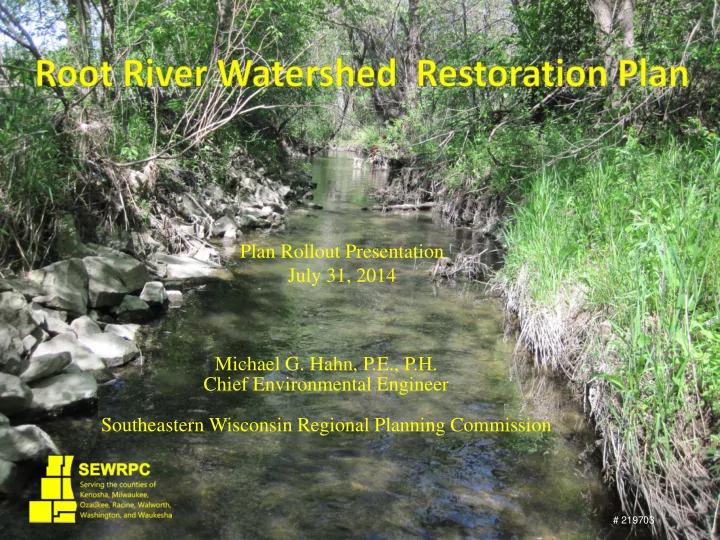

Plan Rollout Presentation July 31, 2014 Michael G. Hahn, P.E., P.H. Chief Environmental Engineer Southeastern Wisconsin Regional Planning Commission # 219703
Racine County Flooding Recommendations and Horlick Dam Evaluation
Racine County Flooding Recommendations 1. Root River Mainstem in City of Racine Consider working with FEMA and WDNR to conduct flood mitigation planning under the RiskMAP program 2. Scattered Buildings in the Floodplain Throughout the Watershed in Racine County Determine the most cost ‐ effective combination of nonstructural approaches Request that nonstructural alternatives be given primary consideration under future FEMA RiskMAP activities Seek funding to evaluate nonstructural flood mitigation alternatives
Racine County Flooding Recommendations 3. Flooding of Roadways in the County Identify roadways that could overtop during flooding using 2012 FEMA flood insurance study or updated flood profiles developed in the future under RiskMAP Consider bridge and culvert modifications to provide adequate hydraulic capacity to meet road overtopping standards
Racine County Flooding Recommendations 4. Stormwater Runoff Problems Affected municipalities, stormwater utility districts, and/or Racine County Drainage Board prepare stormwater management plans These plans provide Minor stormwater management system with capacity for runoff from the 10 ‐ percent ‐ annual ‐ probability (10 ‐ year) event A major stormwater management system with capacity of runoff from the 1 ‐ percent ‐ annual ‐ probability (100 ‐ year)event An emergency overflow route to convey the peak rate of runoff to receiving streams during events with probabilities less than 1 percent
Horlick Dam
Reasons for Horlick Dam Evaluation The dam must be upgraded to meet State standards, or demolished and removed. Doing nothing is not an option. Horlick dam break analysis completed by County consultant and reviewed by WDNR Dam assigned a Low Hazard rating which requires a 100 ‐ year spillway capacity Low Hazard rating indicates failure or mis ‐ operation of the dam would result in no probable loss of human life, low economic losses, low environmental damage, no significant disruption of lifeline facilities, and have land use controls in place to restrict future downstream development in the hydraulic shadow.
Reasons for Horlick Dam Evaluation Horlick dam as constructed has a 10 ‐ year spillway capacity The County may have up to 10 years to perform modifications to meet the spillway capacity requirement if they choose to maintain the dam
Engineering Process WDNR Hazard Rating Determination WDNR Order Feasibility Analysis (Conceptual Alternatives) and SEWRPC Recommendation Racine County Decision on How to Proceed Preliminary Engineering Final Design Plans and Specifications Construction/Demolition
Horlick Dam Five Alternatives Lower current dam spillway for one ‐ percent ‐ annual ‐ probability (100 ‐ 1. year) flood capacity Modify current fishway in addition to Alternative 1 changes 2. Lengthen current dam spillway and raise abutments for one ‐ percent ‐ 3. annual ‐ probability flood capacity Full notch of current dam spillway 4. Full removal of dam 5.
1 2
3 4 5
Horlick Dam Alternatives Issues of Concern Water Quantity Water Quality Natural Resources Social Costs
Evaluation of the Status of the Dam Environmental considerations: Water quality, fish community effects, and flooding Cultural Considerations: Recreation, safety, and riparian landowner issues Cost
Evaluation of Environmental, Cultural, and Cost Considerations
SEWRPC Recommendation Based on environmental considerations alone, it is recommended that the dam be abandoned and removed Potential positive environmental effects: Long ‐ term improvements in water quality upstream and downstream of the dam Overall improvement in the quality and abundance of the fishery Reduced upstream flood levels from the dam site to STH 31, and no change in downstream flood levels Potential negative environmental effects Possibility for aquatic invasive species (AIS) and viral hemorrhagic septicemia (VHS) to be transmitted upstream of the dam Potential for downstream transport of sediment accumulated in the impoundment
SEWRPC Recommendation Potential negative environmental effects Possibility for aquatic invasive species (AIS) and viral hemorrhagic septicemia (VHS) to be transmitted upstream of the dam Competes with positive overall fish community improvement Connection of Root River and tributaries to Lake Michigan should result in more healthy, diverse, and abundant fishery Viable fish population more likely to be sustained and remain viable in the presence of AIS and VHS Potential for downstream transport and deposition of sediment accumulated in the impoundment Relatively short ‐ term effect Mitigate sediment transport through staged, incremental lowering of dam crest and establishment of vegetation on exposed sediment
Racine County’s Decision Cultural and Cost Considerations Best assessed by County staff and County Board Knowledge of local attitudes and preferences Fiscal considerations Input from local units of government and the public SEWRPC recommendation and plan’s characterization and quantification of cultural and cost aspects
Recommend
More recommend